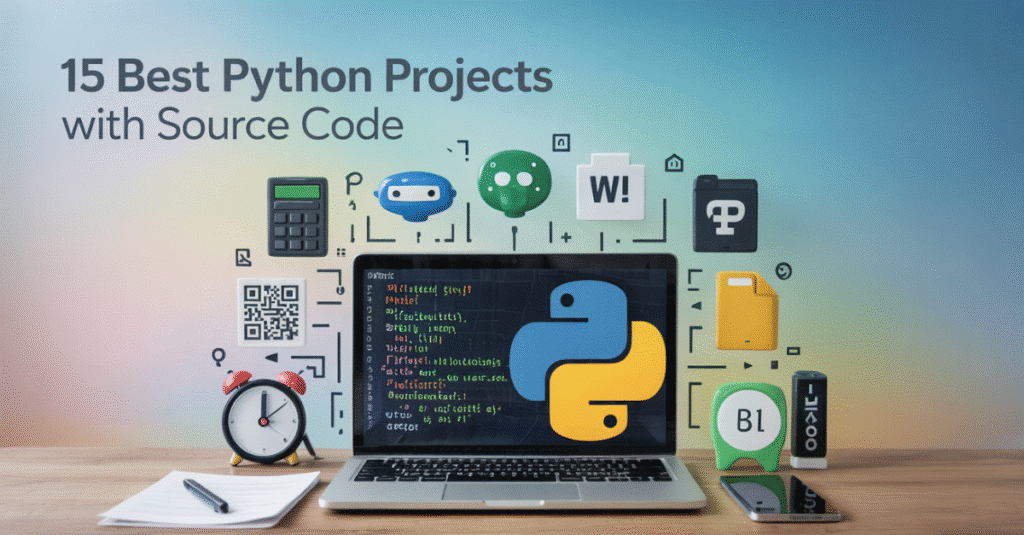
Want to build real Python projects with source code? You’re in the right place. These projects go beyond “print(‘Hello World’)” and actually help you learn, build, and impress employers.
Short Answer:
Here are 15 high-impact Python projects, all with source code. Perfect for beginners, intermediate learners, and job-seeking devs.
Why Build Python Projects?
- 72% of recruiters say hands-on projects are more valuable than certificates. (LinkedIn Hiring Survey, 2023)
- Real projects help you retain concepts 5X better than passive tutorials. (ResearchGate, 2022)
- Portfolios with real GitHub links get 3x more interview callbacks. (Indeed data, 2023)
Bottom line? Projects make you job-ready, not just course-complete.
1. To-Do List App (Beginner, GUI-Based)
- Tech Used: Python, Tkinter
- Functionality: Add/delete tasks, check off completed ones
- Use Case: Build the base for task managers or productivity apps
- Pro Insight: Add SQLite to save tasks permanently
2. Python Calculator (Beginner, GUI)
- Libraries: Tkinter
- Includes: Basic operations (add, subtract, etc.)
- What You Learn: Event handling, widget layout
- Tip: Try creating a scientific calculator later
3. QR Code Generator (Utility Tool)
- Libraries: qrcode, PIL
- Output: Generate a QR code image from text or links
- Real Usage: Portfolio links, resumes, digital business cards
- Upgrade Tip: Add a GUI and option to embed a logo
4. URL Shortener (API-based)
- Library: pyshorteners
- Core Idea: Convert long URLs to short custom links
- Real-Life Use: For portfolio, affiliate marketing, or personal sites
- Scalability Tip: Integrate Firebase or Django backend
5. Weather App Using API (Intermediate)
- Library: requests
- Data Source: OpenWeatherMap API
- Skills Learned: API handling, error catching, JSON parsing
- Upgrade Tip: Add voice input or GUI
6. Chatbot using NLTK (NLP Starter)
- Libraries: nltk, random
- How It Works: Matches patterns in user input
- Upgrade Tip: Add TensorFlow for ML-based learning
- Real Usage: Customer support prototypes, basic virtual assistants
7. File Organizer (Automation Project)
- Libraries: os, shutil
- Function: Sorts files in a folder by type (PDFs, images, etc.)
- What You Learn: File handling, automation scripting
- Real Use Case: Clean up your Downloads folder (you know it’s messy)
8. Expense Tracker (Practical Finance App)
- Libraries: sqlite3, Tkinter
- Tracks: Income, expense, categories
- Resume Tip: Great for showcasing database CRUD skills
- Extension Idea: Add pie charts with matplotlib
9. Number Guessing Game (For Logic Practice)
- Library: random
- Gameplay: User guesses a randomly generated number
- Learning Focus: Loops, input/output, conditional statements
- Challenge Idea: Add a leaderboard using a file
10. PDF Merger Tool (Document Automation)
- Library: PyPDF2
- Function: Combines multiple PDF files into one
- Practical Use: Create final reports, merge bills or notes
- Resume Highlight: Real-world file handling experience
11. Face Detector (Computer Vision)
- Library: OpenCV
- How It Works: Uses Haar cascade classifier to detect faces
- Real Use Case: Surveillance, facial login, or fun filters
- Next Level: Build face recognition + emotion detection
12. YouTube Video Downloader (Network + Media)
- Library: pytube
- Function: Download videos using video ID
- Advanced Use: Add quality options, playlists, GUI
- Use Case: Offline access, archiving content
13. Alarm Clock (Time-Based Automation)
- Libraries: datetime, time, playsound
- What It Does: Plays a sound at a set time
- Skills Learned: Time modules, scheduling logic
- Fun Tip: Turn this into a daily reminder or break timer
14. Password Generator (Cybersecurity Basics)
- Libraries: string, random
- Function: Generates strong, customizable passwords
- Upgrade Tip: Add password strength indicator
- Practical Angle: Cybersecurity awareness, tool building
15. Amazon Price Tracker (Web Scraping)
- Libraries: requests, BeautifulSoup
- Function: Checks price of a product every hour
- Bonus Tip: Send email alert when price drops
- Use Case: E-commerce bots, deal finders
What Makes These Projects Stand Out?
| Feature | Benefit |
| Real APIs | Learn how apps connect to real data |
| Source Code | Understand logic behind each project |
| GUI + CLI mix | Covers both visual and terminal apps |
| Automation Ideas | Save time, build useful tools |
| Career-focused | Shows your actual coding skills |
What to Do After Building These?
- Push to GitHub
- Write a short README
- Explain what you learned
- Add screenshots or a demo video
- Link it on your resume or LinkedIn
Fun Fact: Portfolios with even 3 good GitHub projects get 5X more attention from tech recruiters. (Glassdoor, 2023)
Final Thoughts
If you’re learning Python development in 2025 and NOT building projects, you’re doing it wrong. These aren’t just exercises, they’re mini proof-of-work, problem-solving sessions, and confidence boosters.
The fastest way to learn Python and get hired? Build. Fix. Repeat.
